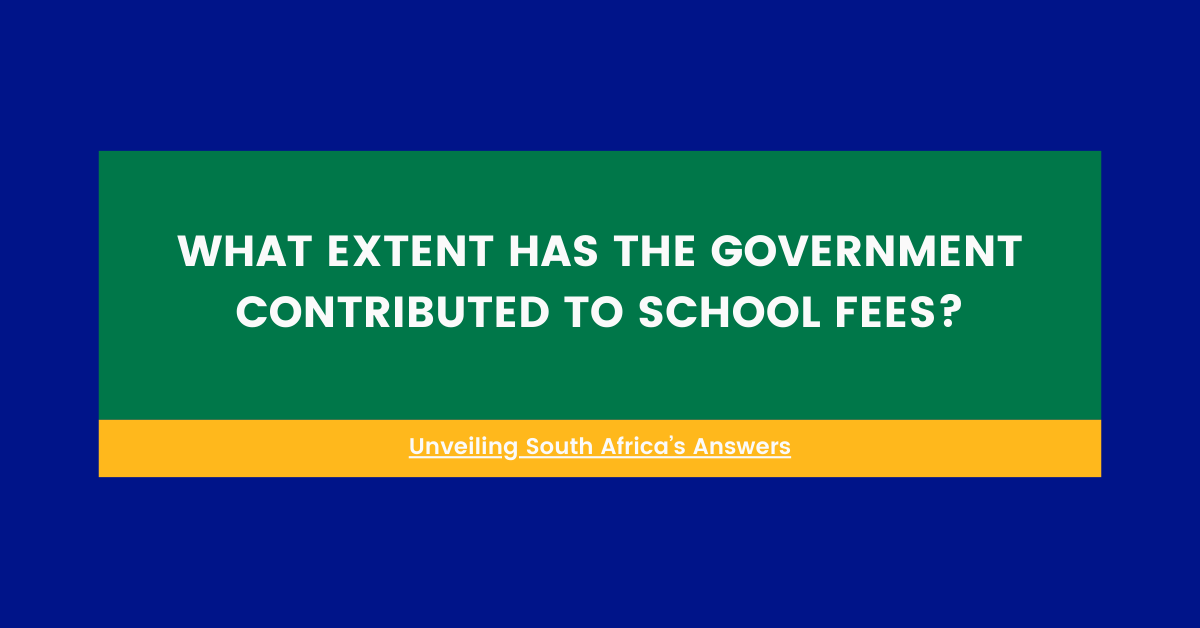In South Africa, education is a key focus for the government. The question of how much the government has contributed to school fees is important for many families. Let’s explore this topic in detail, looking at the government’s efforts, challenges, and the impact on students and families.
Understanding School Fees in South Africa
Before we dive into the government’s role, let’s clarify what school fees are in South Africa:
- Public Schools: These are state-funded schools that may charge fees.
- Private Schools: These schools set their own fees and get limited state support.
- No-Fee Schools: These are public schools where the government covers all costs.
The Government’s Contribution
The South African government has taken several steps to make education more affordable:
No-Fee School Policy
In 2007, South Africa introduced the no-fee school policy. This was a big step in helping poor families access education.
- The government ranks schools from Quintile 1 to 5 based on the poverty of the community.
- Schools in Quintiles 1 to 3 are typically no-fee schools.
- As of 2022, about 65% of public schools in South Africa are no-fee schools.
School Fee Exemptions
For schools that do charge fees, the government has a system to help poor families:
- Parents can apply for full or partial exemption from school fees.
- The school and government look at the family’s income to decide.
- This helps many children stay in school even if their parents can’t afford the fees.
Subsidies to Public Schools
The government gives money to public schools to cover various costs:
- This includes money for learning materials, maintenance, and services.
- The amount varies based on the school’s quintile ranking.
- Poorer schools (lower quintiles) get more money per student.
National School Nutrition Programme
While not directly related to fees, this program helps make school more affordable:
- It provides free meals to students in poor areas.
- This saves families money and helps children focus on learning.
Funding for School Infrastructure
The government spends money to build and fix schools:
- This includes classrooms, toilets, and other facilities.
- Better facilities can lead to lower maintenance costs for schools.
Challenges in Government Contribution
Despite these efforts, there are still some problems:
Budget Constraints
- The government has limited money to spend on education.
- This means they can’t always give as much as schools need.
Inequality Between Schools
- Schools in richer areas often have better facilities and more resources.
- This is because they can charge higher fees and get more support from parents.
Quality of Education
- Some worry that no-fee schools might offer lower quality education.
- This is because they have less money overall compared to fee-charging schools.
Administrative Issues
- Sometimes, the money from the government doesn’t reach schools on time.
- This can cause problems for schools trying to pay for daily needs.
Impact on Families and Students
The government’s efforts have had a big impact:
Increased Access to Education
- More children, especially from poor families, can now go to school.
- This helps reduce inequality in the long run.
Financial Relief for Families
- Many families now spend less on education.
- This leaves more money for other important needs like food and healthcare.
Improved Nutrition
- The school feeding program helps children get at least one good meal a day.
- This improves their health and ability to learn.
Challenges for Middle-Income Families
- Families that don’t qualify for fee exemptions but still struggle financially might face difficulties.
- They may have to make tough choices about which school to send their children to.
Comparison with Other Countries
To understand South Africa’s efforts better, let’s look at how other countries handle school fees:
- Finland: All education, including university, is free.
- United States: Public schools are free, but quality can vary greatly between areas.
- Kenya: Has a free primary education policy, but secondary school still has fees.
- Brazil: Public education is free, but many families choose private schools for better quality.
South Africa’s approach is somewhere in the middle. It tries to make education free for the poorest while still allowing some schools to charge fees.
Future Directions
The South African government continues to work on improving education access:
Expanding No-Fee Schools
- The goal is to increase the number of no-fee schools.
- This would help more families access free education.
Improving Quality in No-Fee Schools
- The government is working to ensure no-fee schools offer good education.
- This includes better training for teachers and more learning resources.
Technology in Education
- Plans to increase use of computers and internet in schools.
- This could help reduce costs for textbooks and other materials.
Public-Private Partnerships
- Working with businesses to support schools.
- This could bring in more money without raising fees.
What Families Can Do
If you’re a parent in South Africa, here are some steps you can take:
- Know Your Rights: Learn about fee exemptions and how to apply.
- Get Involved: Join the school governing body to have a say in school finances.
- Seek Help: If you’re struggling with fees, talk to the school principal or social worker.
- Support Your School: Even in no-fee schools, parents can help through volunteering or donations.
